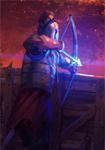Foreword:
Hey guys, we’re back to our regularly scheduled programming (blog schedule) as we formally close our crowdfunding round. While the outcome was unfortunate (see our closing remarks here: https://www.kickstarter.com/projects/criticalforge/forged-of-blood/posts/1877218 ) we are excited to go back to our (more or less) regular production schedule as the team is no longer stretched out in trying to chase down PR leads and maintaining the campaign. To everyone who keeps up with us here and on the communities we are always open to your comments and suggestions so please do continue to engage us. To start us off with a bang, Ken’s here to talk about our most recent overhauls to Forged of Blood:
The UI Overhaul
Hello readers, this is Ken writing, and I am back with a post covering our UI (User Interface) and more specifically UX (or User Experience), and their evolution. For this blog, I will focus on the Tactical Layer specifically.
Rethinking Our Tactical Layer
While our first run at the UI design worked well from the art standpoint (Igor and I are very happy with the minimalist fantasy thing we have going on), our trips to Gameprime Asia 2016 and PAX East 2017 gave us a lot of to reflect on. During the events, we had players play our Tactical Layer gameplay. Although there were a lot of gameplay improvements from Gameprime to PAX, the UI and UX remained consistent throughout, so feedback and criticism about the UI were taken very seriously by us. One of the most jarring UI issues we saw was that players kept trying to hit enemies behind cover using low-level Maul attacks – with a 0% Hit Chance. This concerned us as this meant that the displayed tactical information was not conveyed well to the players.
In the old Tactical UI, when a player had to make a decision to attack an enemy, their eyes needed to shift to the bottom left area to check their attack’s Hit Chance. While if you need to check the status of the enemy you had selected, you had to look towards the bottom right area. This huge space gap of space between the displayed information was very unintuitive as players will tend to be oblivious about the information presented.
[...]


